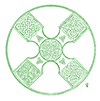 The EarthSpirit Newsletter Winter 94
The EarthSpirit Newsletter Winter 94
Imbolc: A Celebration of the Coming Spring
by Anne Lafferty
The temperature is only a few degrees above zero and the wind chill factor brings it down to twenty below. This morning you had to wait three times as long as usual for your subway train because, somewhere on the line, a switch had frozen shut. A few days ago there was a snowstorm and another one is expected tomorrow night. The sidewalks are covered with several inches of ridged ice and almost every time you cross the street you have to clamber in and out of snowbanks at the sides. All your co-workers are saying that winter will never end and you’re beginning to think that they’re right. So, why, precisely, are you leaving your warm home and travelling all the way across town in the evening to do a ritual?
Unlike the modern Pagan calendar, in which we celebrate eight major festivals, in the Celtic calendar, only four holidays were recognized to mark the changes of the seasons. Samhain was the beginning of winter, Beltaine the beginning of summer, Lughnassad the first of autumn, and February 1st brought Imbolc, the celebration of the onset of spring. Later under the influence of Christianity, February I became St. Brigid’s Day. Brigid, of course, was originally a Celtic goddess. I would like to think the goddess outright turned into the saint; it is also possible that there actually was a woman with the same name as the goddess who did some of the things that the saint is supposed to have done, but whose myths and worship were heavily influenced by that of the goddess. In any case, since relatively little is known about the myths and attributes of Brigid as goddess, or of the practices observed in her honor, and a significant amount is known about all of these things for Brigid as saint, it makes sense to draw (cautiously) upon what is known about Brigid as saint to get a sense of Brigid as goddess.
Brigid, or Bride, as she was sometimes called, was the power informing a remarkably diverse set of activities, including smithcraft, healing, poetry, marriage, the hearth and birth. She also has recurring associations with cattle and milking (hence Oimelc, or “ewe’s milk”, was a name for the feast). Most important for our immediate purposes, she is strongly connected with fertility and with the return of plant life in the spring.
Workshop leader Deborah Brien describes her as “not maternal, but pre-maternal.” She is connected with midwifery and in the Hebrides she would be ritually asked, by one of the women in attendance, to come into the house when a woman was giving birth. Similarly, on the eve of her day (January 31st), one of the women of the house would ask Bride to enter. Although these customs are not completely parallel (the wording of the invitations is different and, on the eve of her day, this request to Bride is part of a whole set of customs not directly related to birth) in some sense Bride can be seen as the midwife at the birth of the coming spring.
Clearly, this is not a festival of full-blown spring. Signs of returning spring are very subtle at this time, especially in New England. They do, however, exist. The most obvious is that the length of the days has increased. The sun is also stronger and snow and ice melt more readily than they do earlier in the year, even when the temperature is very low. I usually start looking for snowdrops and crocuses around this time of year – this may be a little early to expect to actually find any, but it is not outrageously so (although crocuses will not actually bloom for weeks to come). Agriculturally, (at least in the somewhat milder climate of Great Britain) geese begin laying and ewes giving milk. As February progresses, cows also begin to give milk.
There were – and in some places still are – a variety of practices observed on this day or its eve. One custom, which probably arises from the renewed availability or milk at this time, is to pour some milk over your threshold. A practical modern-day adaptation might be to take just a few drops of milk and anoint the threshold with it
In Scotland, Imbolc was the traditional time to get rid of the last sheaf of grain from your harvest, preferably by feeding it to your plow horses in the fields before beginning to plow, thus connecting the old cycle of growth and harvest with the new one. If you don’t have grain fields or plow horses, but did make a carline (corn dolly) last summer, you may want to dispose of it at this time in some other way, perhaps by burning or composting.
In the most ancient times and in modern days all across Celtic lands – Oimelc, Imbolc, Brigid – this Pagan feast has persisted in celebrating the very beginnings of spring.